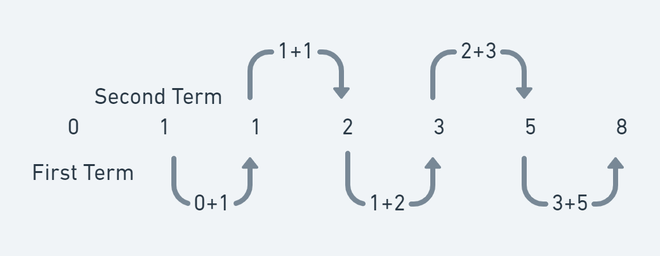斐波那契数列公式
斐波那契数列是数论中最著名的公式之一。在斐波那契数列中,序列中的每个数字都是通过将其前面的两个数字相加来计算的。一般来说,斐波那契数列的前两项是 0 和 1。斐波那契数列早在 Leonardo Pisano Bogollo 知道它的数百年前就在印度为人所知。 11 月 23 日被庆祝为斐波那契日,因为它有数字“1、1、2、3”,这是序列的一部分。
斐波那契数列如下:
0, 1, 1, 2, 3, 5, 8, 13, 21, 34, 55, 89, 144, 233, 377, 610, 987, 1597, 2584, 4181, 6765, 10946,….
斐波那契数列对其在高等数学和统计学、计算机科学、经济学和自然方面的运算很有用。

斐波那契数列
斐波那契数的公式
Fn = Fn-1 + Fn-2
- Fn is term number “n”
- Fn−1 is the previous term (n−1)
- Fn−2 is the term before that (n−2)

斐波那契数的计算
要计算第 5 个斐波纳契数,请将第 4 个和第 3 个斐波纳契数相加。
黄金比例
在选择任何两个连续的(一个接一个)斐波那契数时,它们的比率接近 1.618034,称为黄金比率。用“φ”表示。黄金比例一般可以在自然界中看到,当应用于设计时,它会培养出看起来自然、赏心悦目的作品。在建筑领域,黄金比例的操作数不胜数。例如,埃及大金字塔和凯鲁万大清真寺是许多应用了黄金比例概念的建筑奇迹。
例如:X Y Y/X 2 3 1.5 3 5 1.6666 5 8 1.6 8 13 1.625 13 21 1.6154 21 34 1.6190 34 55 1.6176 55 89 1.6181 89 144 1.6179
Note: Golden Ratio can be calculated from Any Fibonacci sequence, it does not necessarily have to start with 2 and 3.
使用黄金比例计算斐波那契数
任何斐波那契数都可以使用这个公式计算,
xn = (φn − (1−φ)n)/√5
xn denotes Fibonacci number to be calculated
φ is Golden ratio that is 1.618034
例如:如果要计算第 7 项:
x7 = ((1.618034)7-(1-1.618034)7)/√5
x7 = 13.0000007
x7 = 13(rounded off)
下一个斐波那契数也可以使用黄金比例来计算。将斐波那契数乘以黄金比例将得到序列的下一个斐波那契数。但这仅适用于大于 1 的数字。
示例:13*1.618034 = 21.034442 = 21(四舍五入)
基于黄金比例的一些问题
问题 1:如果给定的黄金比例是 1.618034,则计算第 9 个斐波那契数。
解决方案:
We can calculate the 9th Fibonacci number by using the formula:
xn = (φn − (1−φ)n)/√5
x9 = ((1.618034)9-(1-1.618034)9)/√5
x9 = (76.0131604-(-0.0131556197))/√5 = 34.0000021
x9 = 34
问题 2:找到在上述问题中计算的下一个斐波那契数的答案。
解决方案:
Next Fibonacci number of 34 can be easily found by multiplying it by the Golden ratio that is 1.618034.
x10 = 34×1.61803 = 55.01302
x10 = 55(rounded off)
基于斐波那契数的一些问题
问题 1:如果斐波那契数列的第 5 项和第 6 项分别为 3 和 5,则求该数列的第 7 项。
解决方案:
With the use of the Fibonacci Sequence formula, we can easily calculate the 7th term of the Fibonacci sequence which is the sum of the 5th and 6th terms.
seventh term = 5th term + 6th term
= 3+5
= 8
The 7th term of the Fibonacci sequence is 8.
问题 2:斐波那契数列中的前 4 个数字分别为 1、1、2、3。
(a) 斐波那契数列的第八项是什么?
(b) 斐波那契数列的第十一项是什么?
解决方案:
By the use of the Fibonacci number formula, we can calculate the rest of the Fibonacci numbers like 1, 1, 2, 3, 5, 8, 13, 21, 34, 55, 89.
(a) Therefore, the 8th term will be 21.
(b) 11th term will be 89.
问题 3:找出以下每个斐波那契式序列的下 3 个项。
(a) x、4x、5x、9x、……
(b) 3a、3a+b、6a+b、9a+2b……。
解决方案:
With the use of the Fibonacci Sequence formula, we can easily calculate the rest of the terms
(a) Fifth term = 5x+9x = 14x,
Sixth term = 9x+14x = 23x,
Seventh term = 14x+23x = 37x
(b) Fifth term = 6a+b+9a+2b = 15a+3b,
Sixth term = 9a+2b+15a+3b = 24a+5b,
Seventh term = 15a+3b+24a+5b = 39a+8b
问题 4: John 想要生成一个斐波那契数列,第一项为 3,第二项为 4。
(a) 找出第 3 项和第 4 项。
(b) 他认为前十项之和等于他的数列第七项的十一倍。检查他是否正确。
解决方案:
Using the 3 and 4 as first and second terms, we can calculate the rest of the terms by simply adding the last two terms.
(a) First term = 3,
Second term = 4,
Third Term = 3+4=7,
Forth term = 4+7 = 11
(b) On calculating the first ten terms of the series: 3,4,7,11,18,29,47,76,123,199.
Sum of first ten terms = 3+4+7+11+18+29+47+76+123+199 = 517
7th term = 47
Eleven times the 7th term = 11*47 = 517
As we can see that the sum of the first ten terms is equal to eleven times the seventh term of his sequence. Therefore, John was correct.
问题 5:如果前 4 项是 0、1、1、2,斐波那契数列中出现的第一个三位数平方数是多少。
解决方案:
With the use of the Fibonacci Sequence formula, we can easily calculate the rest of the terms:
0,1,1,2,3,5,8,13,21,34,55,89,144,233,377,…
As we can see the first three-digit number which is a square that appears on the list of Fibonacci numbers is 144(square of 12).